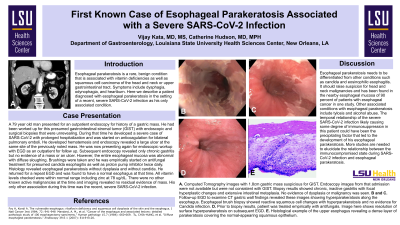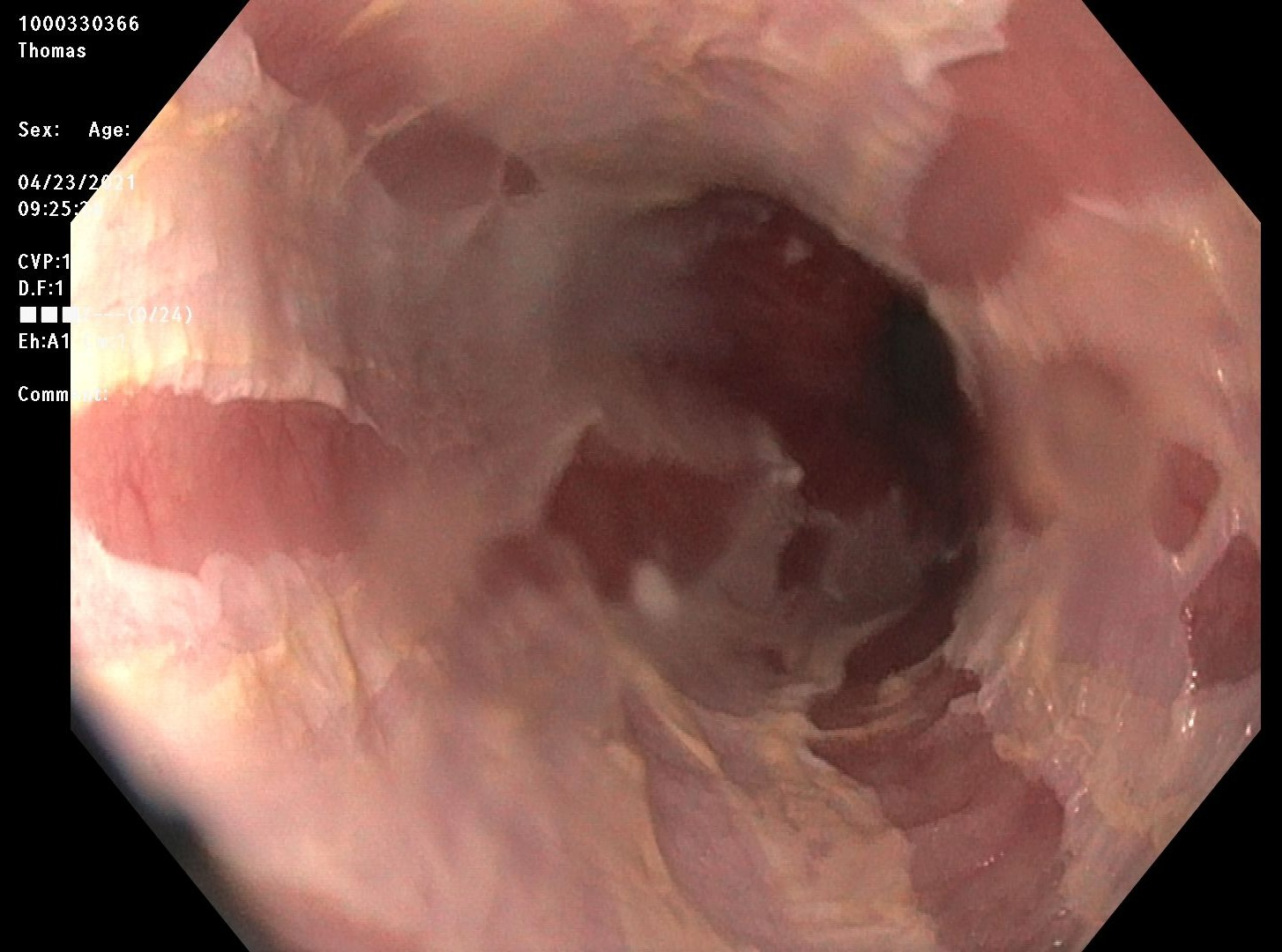Back


Poster Session C - Monday Afternoon
Category: Esophagus
C0259 - First Known Case of Esophageal Parakeratosis Associated With a Severe SARS-CoV-2 Infection
Monday, October 24, 2022
3:00 PM – 5:00 PM ET
Location: Crown Ballroom

Has Audio

Vijay Kata, MS, MD
Louisiana State University Health Sciences Center
Chicago , IL
Presenting Author(s)
Vijay Kata, MS, MD1, Catherine Hudson, MD, MPH2
1Louisiana State University Health Sciences Center, Kankakee, IL; 2Louisiana State University Health Sciences Center, New Orleans, LA
Introduction: Esophageal parakeratosis is a rare, benign condition that is associated with vitamin deficiencies as well as squamous cell carcinoma of the head and neck or upper gastrointestinal tract. Symptoms include dysphagia, odynophagia, and heartburn. Here we describe a patient diagnosed with
esophageal parakeratosis in the setting of a recent, severe SARS-CoV-2 infection as his only associated condition.
Case Description/Methods: A 79 year old man presented for an outpatient endoscopy for history of a gastric mass. He had been worked up for this presumed gastrointestinal stromal tumor (GIST) with endoscopic and surgical biopsies that were unrevealing. During that time he developed a severe case of SARS-CoV-2 with prolonged hospitalization and was started on anticoagulation for bilateral pulmonary emboli. He developed hematemesis and endoscopy revealed a large ulcer at the same site of the previous noted mass instead of the previously. He was now presenting for endoscopic workup with EGD as an outpatient for follow up. Endoscopy revealed only chronic gastritis but no evidence of mass or ulcer. However, the entire esophageal mucosa was abnormal with diffuse sloughing. Brushings were taken and he was empirically started on antifungals for presumed candida esophagitis as well as proton pump inhibitor twice daily. Histology revealed esophageal parakeratosis without dysplasia without candida. He returned for a repeat EGD and was found to have a normal esophagus at that time. All vitamin levels checked were within normal range including zinc at 78 ug/dL. There were no other known active malignancies at the time and imaging revealed no residual evidence of mass. His only other association during this time was the recent, severe SARS-CoV-2 infection.
Discussion: Esophageal parakeratosis needs to be differentiated from other conditions such as candida and eosinophilic esophagitis. It should raise suspicion for head and neck malignancies and has been found in the nearby esophageal mucosa of 90 percent of patients with esophageal cancer in one study. Other associated conditions with esophageal parakeratosis include tylosis and alcohol abuse. The temporal relationship of the severe SARS-CoV-2 infection likely causing some degree of immunosuppression in this patient could have been the precipitating factor that led to the development of his esophageal parakeratosis. More studies are needed to elucidate the relationship between the immunocompromised state during SARS-CoV-2 infection and esophageal parakeratosis.

Disclosures:
Vijay Kata, MS, MD1, Catherine Hudson, MD, MPH2. C0259 - First Known Case of Esophageal Parakeratosis Associated With a Severe SARS-CoV-2 Infection, ACG 2022 Annual Scientific Meeting Abstracts. Charlotte, NC: American College of Gastroenterology.
1Louisiana State University Health Sciences Center, Kankakee, IL; 2Louisiana State University Health Sciences Center, New Orleans, LA
Introduction: Esophageal parakeratosis is a rare, benign condition that is associated with vitamin deficiencies as well as squamous cell carcinoma of the head and neck or upper gastrointestinal tract. Symptoms include dysphagia, odynophagia, and heartburn. Here we describe a patient diagnosed with
esophageal parakeratosis in the setting of a recent, severe SARS-CoV-2 infection as his only associated condition.
Case Description/Methods: A 79 year old man presented for an outpatient endoscopy for history of a gastric mass. He had been worked up for this presumed gastrointestinal stromal tumor (GIST) with endoscopic and surgical biopsies that were unrevealing. During that time he developed a severe case of SARS-CoV-2 with prolonged hospitalization and was started on anticoagulation for bilateral pulmonary emboli. He developed hematemesis and endoscopy revealed a large ulcer at the same site of the previous noted mass instead of the previously. He was now presenting for endoscopic workup with EGD as an outpatient for follow up. Endoscopy revealed only chronic gastritis but no evidence of mass or ulcer. However, the entire esophageal mucosa was abnormal with diffuse sloughing. Brushings were taken and he was empirically started on antifungals for presumed candida esophagitis as well as proton pump inhibitor twice daily. Histology revealed esophageal parakeratosis without dysplasia without candida. He returned for a repeat EGD and was found to have a normal esophagus at that time. All vitamin levels checked were within normal range including zinc at 78 ug/dL. There were no other known active malignancies at the time and imaging revealed no residual evidence of mass. His only other association during this time was the recent, severe SARS-CoV-2 infection.
Discussion: Esophageal parakeratosis needs to be differentiated from other conditions such as candida and eosinophilic esophagitis. It should raise suspicion for head and neck malignancies and has been found in the nearby esophageal mucosa of 90 percent of patients with esophageal cancer in one study. Other associated conditions with esophageal parakeratosis include tylosis and alcohol abuse. The temporal relationship of the severe SARS-CoV-2 infection likely causing some degree of immunosuppression in this patient could have been the precipitating factor that led to the development of his esophageal parakeratosis. More studies are needed to elucidate the relationship between the immunocompromised state during SARS-CoV-2 infection and esophageal parakeratosis.

Figure: Esophageal Parakeratosis
Disclosures:
Vijay Kata indicated no relevant financial relationships.
Catherine Hudson indicated no relevant financial relationships.
Vijay Kata, MS, MD1, Catherine Hudson, MD, MPH2. C0259 - First Known Case of Esophageal Parakeratosis Associated With a Severe SARS-CoV-2 Infection, ACG 2022 Annual Scientific Meeting Abstracts. Charlotte, NC: American College of Gastroenterology.
